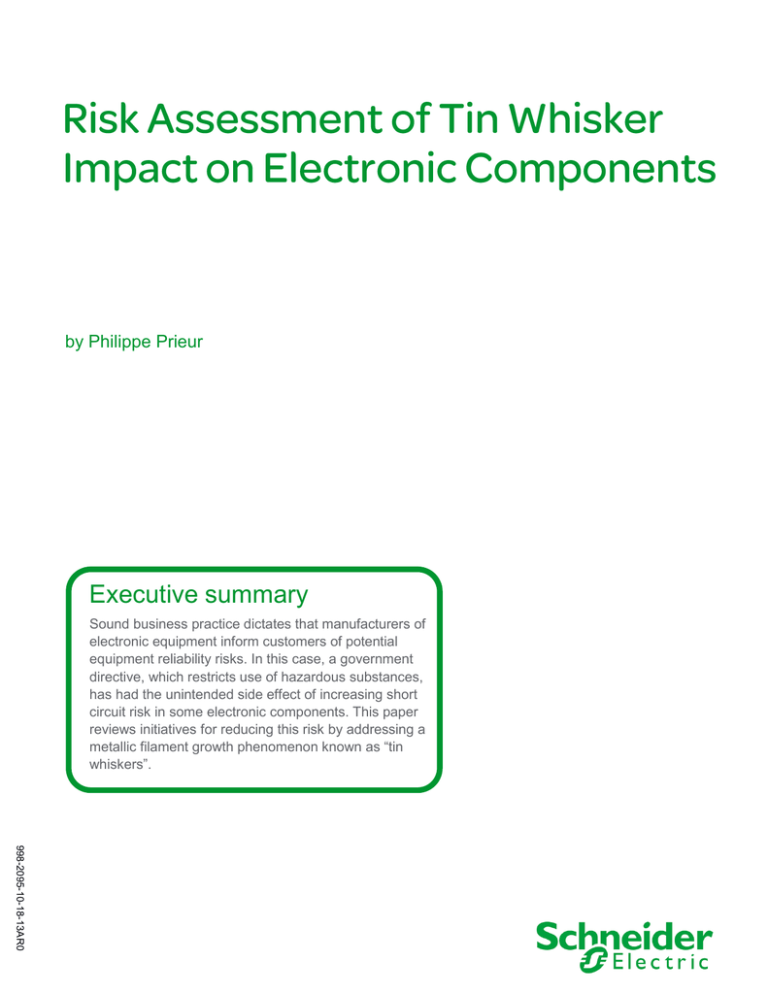
by Philippe Prieur
Executive summary
Sound business practice dictates that manufacturers of
electronic equipment inform customers of potential
equipment reliability risks. In this case, a government
directive, which restricts use of hazardous substances,
has had the unintended side effect of increasing short
circuit risk in some electronic components. This paper
reviews initiatives for reducing this risk by addressing a
metallic filament growth phenomenon known as “tin
whiskers”.
998-2095-10-18-13AR0
Risk Assessment of Tin Whisker Impact on Electronic Components
Introduction
European Directive 2002/95/EC “Restriction of Hazardous Substances” (RoHS) forbids the
use in Europe of lead, mercury, cadmium, hexavalent chromium and the polybrominated
biphenyls (PBB) and polybrominated diphenyl ethers (PBDE) flame retardants in certain
electrical and/or electronic equipment.
Schneider Electric fully supports this directive and, in fact, has gone beyond the strict
provisions of the directive to help eliminate the presence of such hazardous subs tances in its
products.
While the directive is laudable in its effort to embrace environmental policy and sustainable
development, it does complicate and change the way manufacturers need to produce their
electronic components.
In the electronics / electrical industry lead (Pb), which is one of the metals restricted by the
directive, has for many years been used in the manufacturing of electronic components. Lead
was used as a substance that helped abate the development of a phenomenon called “tin
whiskers” on the conductors.
“Whiskers” are conductive metallic filaments that spontaneously grow from plated surfaces
used in electrical and electronics products (for example, electronic component terminations
and metallic shields). The main metals which are susceptible to this phenomenon include tin
(Sn), cadmium (Cd), and zinc (Zn) with the most well known and widespread being tin.
Beginning in the 1950’s the tin whisker issue had been addressed by adding lead (Pb) to the
pure tin plating which prevented tin whisker growth on electronic component termination
finishes.
Whiskers are problematic because they can cause short circuits and arcing in electrical or
electronic equipment by bridging closely spaced electrical conductors such as component
terminations and connector pins (see Figure 1).
Figure 1
Whiskers appear on an
improperly processed tin
finish. The bridging from one
connector pin to another is
sufficient to create a short
circuit.
Tin whisker
bridges two
connector pins
This paper identifies best practices for preventing whisker growth through the development
and deployment of lead-free finishes on electronic components.
Schneider Electric White Paper
Revision 1
Page 2
Risk Assessment of Tin Whisker Impact on Electronic Components
Probable
causes of
whisker
growth
The science behind metal whisker growth is not well understood, but the growth seems to be
triggered by a number of factors:
Residual stresses caused by tin plating characterized by:
o
The plating bath chemistry
o
The electroplating process parameters (e.g. current density)
Mechanically induced stresses:
o
Bending or stretching of the surface after plating (e.g., electronic
components termination bending)
o
Scratches or nicks in the plating (e.g., connector scratching during insertion)
o
Compressive stresses (e.g., screw terminal)
Stresses induced by diffusion of different metals, mainly linked to inter-metallic
compound (IMC) growth;
Thermally induced stresses, caused by coefficient of thermal expansion mismatches
Figure 2
Whiskers are sprouting from
the surface of these terminal
block connectors
Risk
abatement
tactics
To avoid failure due to tin whiskers and to deliver reliable electronics to customers, Schneider
rd
Electric has incorporated best practices from 3 party organizations and standards bodies
1
2, 3
4
5
(such as iNEMI , JEDEC , IEC , or JIS ) and established internal rules and procedures for
minimizing risk in a lead-free environment.
Tactics for reducing the risks include the following:
Integrate whiskers risk evaluation in the electronic component selection process
Emphasize finishes that do not use tin (instead shift to gold or palladium)
In cases where tin is used, only accept tin finishes with mitigation practices (e.g., post
bake) and validate by performing whisker tests according to accepted standards
Perform whisker testing experiments on electronic boards
1
“iNEMI Recommendations on Lead-Free Finishes for Components Used in High Reliability Products,”
version 4 (12-1-06).
2 “
Environmental Acceptance Requirements For Tin Whisker Susceptibility Of Tin And Tin Alloy Surface
Finishes”, JEDEC Standard JESD201A, Sept. 2008.
3
“Measuring whisker Growth on tin and Tin Alloy Surface Finishes” JEDEC standard JESD 22-A121A
(Jul, 08)
4
“Whisker test methods for electronic and electric components” IEC 60068-2-82, (Ed.1, May 23, 07).
5
“Whisker test methods for electronic and electric components” JIS C 60068-2-82, ( Dec 21, 09).
Schneider Electric White Paper
Revision 1
Page 3
Risk Assessment of Tin Whisker Impact on Electronic Components
Apply qualified mitigation coating on the electronic boards
A procedure for testing of electronic boards consists of the following:
1. A damp heat test
2. Monitoring of whisker growth
3. A thermal cycling test
4. Monitoring of whisker growth
Other initiatives to help mitigate risk of “tin whiskers” include:
A guideline manual entitled “Use of Lead Free Components Having a Tin Surface
Finish”, for suppliers
Sponsorship of international meetings for electronic component suppliers to share
technical policies; this helps to assure that components received from suppliers are
compliant to standards
Upgrades to electronic components data bases so that the finish and RoHS regulation
status of each component part number can be identified
Centralization of supplier whisker test results for international standard compliance
analysis
Publication of tin whisker risk and reliability best practices at international conferences
Figure 3 demonstrates results from testing that was performed in Schneider Electric
laboratories.
Figure 3
Lab test results show 150μm
whiskers on the active
component pins (right) and
<10μm whisker growth on
ceramic capacitor using
mitigation practice (left)
Schneider Electric White Paper
Revision 1
Page 4
Risk Assessment of Tin Whisker Impact on Electronic Components
For many years, Schneider Electric has been delivering to the markets RoHS compliant
electronic products, that is to say lead-free electronic components.
Since lead was used in the past to combat the problem of tin whiskers on electronic
components, Schneider Electric has developed a body of best practices for selecting
components that avoid the use of lead while addressing tin whisker problem.
Schneider Electric shares these best practices with both suppliers and the general public for
education purposes and so that any potential future reliability problems related to tin whiskers
can be avoided.
About the author
Philippe Prieur an Edison Group Technical Expert with 14 years of experience, currently
works in Schneider Electric’s Technology Strategy department. His experience includes
application of RoHS standards in the automotive & industrial domains, and performance of
circuit board reliability and failure analysis in Schneider Electric’s Electronics & Materials
Expertise central lab (Grenoble-France).
Schneider Electric White Paper
Revision 1
Page 5
© 2013 Schneider Electric. All rights reserved.
Conclusion



